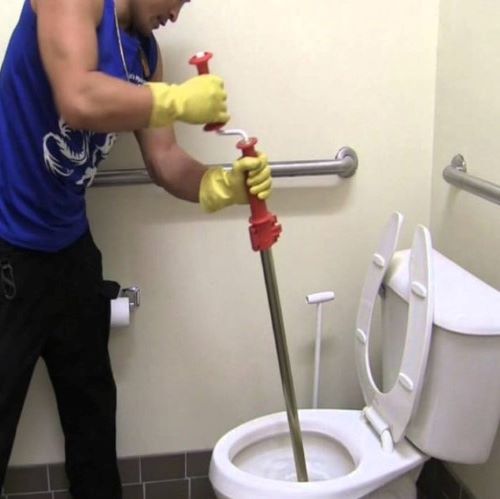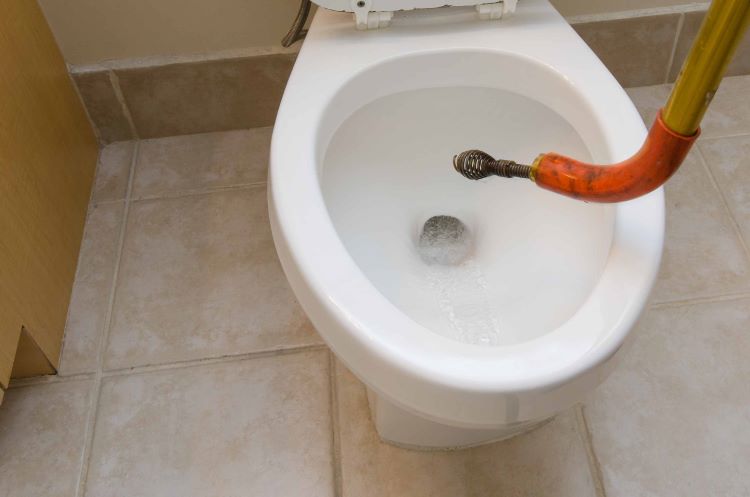What Do I Do When My Toilet Auger Won’t Go In?

So, your toilet is clogged and you’ve turned to your toilet auger––now, it won’t go all the way down. What can you do? If this has happened it’s for one of two reasons. The first is that the auger has hit the clog. The second is that it is having trouble getting through the bends in the pipes.
The simple answer is that you will need to slowly turn your auger while pushing down. This will either break through the clumps or help you to make it through the pipes.
If you’re still struggling with your toilet auger, there are some basics you should know. Keep reading to make sure you’re using it correctly.
76% of Americans report having encountered a clogged public restroom toilet. Most toilet-owners have suffered the same fate within their homes.
A clogged toilet can be seriously troublesome, taking up precious hours in your day. They often require specific tools and skills. Most people’s go-to for toilet clogs are plungers. Plungers work towards the surface of the toilet to create suction and dislodge objects from inside the toilet.
Sometimes though, a plunger simply doesn’t cut it. In these scenarios, you’ll want to turn to a toilet auger.
A toilet auger sometimes called a closet auger is similar to a drain snake. It is inserted in the toilet in order to remove the clog. A toilet auger, however, is for use specifically with toilets.
An auger covers a wider circumference to ensure that the objects obstructing your toilet are removed. A toilet auger can reach deep into the innards of your toilet. It features a bulbous wire end to pick up any debris.
You’ll see that your toilet auger is encased in a hollow plastic or rubber tubing. This is meant to protect your toilet from the tightly wound metal coil of the auger.
When you insert it into your toilet make sure that the protective covering is what touches the bowl. If you don’t do this your toilet will suffer scratches which could lead to cracks and further plumbing issues.
Once your auger is inserted superficially into your toilet, you will push down from the top. The metal part will begin to descend into the piping of the toilet.

Once the toilet auger is in, you’ll begin cranking the handle. It is important here to apply the right amount of pressure. Too much pressure will make your auger come back up and become tangled. Too little will mean that it won’t go down.
Eventually, you will feel more resistance on the auger. This means that you’ve hit your blockage, or you’ve encountered trouble getting through the pipes. To get through the pipes you’ll need to continue to slowly turn that handle and work your way down.
If you still cannot get it through the pipes, try taking the auger out and putting it back in again. If it’s stuck and won’t come out, crank in the opposite direction while pulling.
So, you’ve inserted your auger by spinning it and applying gentle downwards pressure. Now, you might need to jiggle the cable by rotating the handle back and forth.
Jiggling the cable will allow you to get a hold of the blockage and begin to break it down. You might feel the clumps breaking down and may even see the water start to go down the toilet. This means you’re having success breaking the blockage.
You’ve made it this far and either your blockage has begun to disintegrate, or you’ve gotten ahold of it. Now you’ll need to pull the auger out.
To withdraw the toilet auger, turn the handle in the other direction and pull away from the toilet. You may have debris still on the auger that you’ll need to clean later.
Once your auger is out, flush the toilet. If the toilet is able to flush, congratulations! You’ve successfully removed the blockage. However, if the toilet does not flush, you’ll need to try again. It may take a few tries before you’re able to get rid of the blockage and unclog your toilet.
One of the most important things to remember when trying to unclog your toilet is to have patience. Dealing with a clog can be incredibly frustrating. Impatience won’t help you fix the problem any faster.
It may take practice to know how much pressure you need to apply. Applying too much or too little pressure will not have the desired result. If you’re not trained or experienced, this will be a learning process.
When dealing with a difficult clog and a toilet auger, you must understand that it will likely take some work. Don’t be surprised if you break a sweat or get a workout while removing your clog. Be persistent and you’ll get there eventually.
The likely issue if your toilet auger won’t go all the way in is that it has met the blockage. Alternatively, you may be struggling to get it through the piping. Patience and persistence will likely fix these issues.
If your toilet auger is still stuck or not going in, it is possible that it might just be a bad auger. You may be continuing to push down, but every time it springs back up. If you’re applying the right amount of pressure then this is a problem with the auger, not you.
It could simply be a cheap auger. Do your research and purchase an auger that actually works. This will help you avoid toilet auger issues in the future. If it’s a toilet auger that you’ve had for years, it’s possible that it’s run its course. An auger that is too rusted is no longer usable.
There are some issues that you unfortunately won’t be able to fix without professional help. If your auger is stuck and you truly cannot get it out, you will need to call a plumber.
The worst-case scenario is that you will have to have your toilet removed. However, more likely, if you are unable to fix the problem with your toilet, a plumber can.
Your final step once your toilet is cleared and you’ve breathed a sigh of relief is to clean your auger. Don’t disregard this crucial step because ignoring a dirty auger could lead to serious problems down the road.
Fill a bucket with your disinfectant solution or your home-made cleaning solution. Then, submerge your auger in the bucket and allow it to soak for a short time.
It’s very important that your auger soak for no more than five minutes. An auger that soaks for too long will begin to rust.
Next, use a toilet brush to scrub inside of the plastic or rubber tube and remove any dirt. Then, rinse with warm water.
Lastly, you’ll need to ensure that your auger is completely dry by using a rag. Again, storing a wet auger will cause rust and potentially cost you a stuck auger the next time around.
How do I use a toilet auger? To use a toilet auger, insert the auger with the plastic part touching the bowl. Push down to submerge the metal piece in the piping and when you hit the blockage turn the handle to dislodge or break it up.
Pull out by cranking in the opposite direction. Where can I buy a toilet auger? You can purchase a toilet auger at Home Depot or your local hardware store. You can also search for the best augers online.